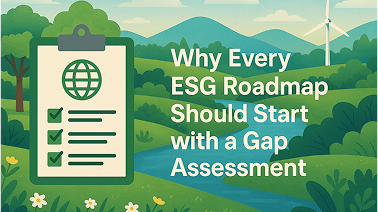Why Every ESG Roadmap Should Start with a Gap Assessment

Using well-known standards like IWA 44, GRI, and CSRD, ESG gap assessment process finds performance gaps and maturity levels in all areas of ESG areas, such as human rights due diligence, reporting waste, and leadership role. For businesses looking to improve their sustainability performance, understanding how to conduct an effective ESG gap assessment can be transformative for their strategic sustainability journey.
What Is an ESG Gap Assessment (And Why It Matters)?
Using well-known standards like IWA 44, GRI, and CSRD, ESG gap assessment process finds performance gaps and maturity levels in all areas of ESG areas, such as human rights due diligence, reporting waste, and leadership role.
Why does this matter? Because ESG transformation requires more than storytelling. It demands structure, accountability, and continuous improvement. With a well-executed gap assessment, you get:
- A maturity score showing your ESG strengths and weaknesses.
- A detailed roadmap for closing gaps.
- Tailored, practical recommendations.
- Benchmarks against industry peers.
It's the ESG equivalent of a diagnostic check-up -- without which no credible long-term strategy can take root. Conducting a thorough gap assessment provides the necessary foundation for developing meaningful sustainability initiatives and tracking progress over time.
The ESG Gap Assessment Framework: What to Analyze
Based on the IWA 44:2024 standard, the ESG gap assessment framework covers seven core areas. Here's a breakdown of each:
Why does this matter? Because ESG transformation requires more than storytelling. It demands structure, accountability, and continuous improvement. With a well-executed gap assessment, you get:
ESG Governance & Strategy
Are ESG risks and responsibilities defined across the organization? Does the board actively oversee sustainability risks? Are ESG metrics embedded in executive KPIs?
Materiality & Stakeholder Relevance
Has the company performed a double materiality assessment? Are stakeholder inputs captured and prioritized? Is the materiality process updated regularly?
Environmental Stewardship
This includes emissions tracking, water and energy management, circular economy practices, biodiversity protection, and transparent reporting of environmental KPIs.
Social Responsibility
Are you making impactful investments in leadership? Are community impacts measured, and are vulnerable groups included in stakeholder engagement?
Corporate Governance
Does ESG factor into board decisions? Is executive compensation linked to ESG performance? Are there whistleblower protections and ethics policies in place?
Reporting & Assurance
Is ESG data verified by a third party? Are assumptions and uncertainties disclosed? Does reporting balance achievements with setbacks?
Continuous Improvement & Benchmarking
Are gaps routinely identified and acted on? Is ESG progress benchmarked against peers? Does the organization learn from past initiatives?
Applying the Framework: A Real-World Look at Danone's ESG Gap Assessment
Intro to the Checklist
Danone's 2023 ESG report was assessed using a 200+ point checklist aligned with IWA 44. The framework applied audit questions across all seven domains to calculate an overall ESG maturity score and highlight specific improvement areas.
Applied to Danone's 2023 ESG Reports
Remote scored an impressive 4.2 out of 5, signaling high ESG maturity. The company excels in areas like:
- ESG governance structures, including a CEO-led Climate Committee and board-level oversight.
- Integration of double materiality into strategy and disclosure.
- Climate commitments with science-based targets and transparent GHG data.
Yet even industry leaders have gaps. For Danone, these included:
- Stakeholder engagement: Missing accessible formats and lack of detailed participation records for vulnerable groups.
- ESG accountability: Clear metrics and consequences for non-executive ESG targets were undefined.
- Assurance: Limited third-party validation — not all ESG data was externally assured.
- Accountability: Few metrics in Danone's commitments and practically all disclosed in a decision setting.
- Biodiversity: Investments were not tracked quantitatively or disclosed as a KPI.
- Data transparency: Methodologies and assumptions for environmental KPIs were brief and could be more rigorous.
Findings and Insights
Danone's assessment shows that even mature ESG performers need continual refinement. Three key lessons emerge:
- Governance Must Go Beyond Leadership: Stakeholder engagement was strong but not always inclusive. Greater organizational capability is less defined. Connecting ESG info at layers of the company — not just the boardroom — remains a frontier.
- Inclusion Requires Structural Change, Not Intention: Stakeholder engagement was present but not always inclusive or well-documented. ESG leaders must intentionally design for accessibility, especially when engaging marginalized communities.
- Transparency is a Moving Target: Danone disclosed a lot — but didn't always explain it calculated things. Without clear assumptions and methods, even good data loses credibility. Third-party assurance and total transparency can close this trust gap.
Conclusion
Sustainability is a journey, not a performance. The most successful ESG strategies don't start with storytelling — they start with clarity. By conducting a rigorous gap assessment, companies like Danone (and those aspiring to follow) gain a grounded understanding of their ESG position and a clear path to move forward with confidence.
Remember that even organizations with robust ESG programs have areas for improvement. The key is to establish a systematic approach, analyzing ESG standards and stakeholder expectations, evaluating ESG governance, and taking ownership and stewardship. A comprehensive gap assessment provides the foundation for this systematic approach, ensuring that ESG initiatives are targeted, measurable, and aligned with broader business objectives.